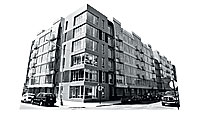
Townhouses and Tenements
Danger: Pancaking.
Built mostly from 1830 to 1910, most have brick side walls and stone or brick façades, with wooden crossbeams. Their simple solidity is their undoing, explains Columbia University civil engineer George Deodatis. When the ground shakes, their shells can’t flex—so they crack, particularly if the masonry is old and crumbly. Also, when the side walls shake, those wooden beams can get jostled loose, dropping all the floors into the basement.

Loft Buildings
Danger: Cracking masonry, falling bricks.
Later loft buildings are built of reinforced concrete, which performs well in a quake—the steel rebar keeps everything tied together, even if cracks form. But the cast-iron façades of the earlier generation are less forgiving, and the walls behind those façades are often brick, which becomes very heavy confetti. Riley says he’s seen whole walls blow out into “brick shrapnel.” Out West, he explains, engineers often seal up old walls with a foot or so of spray-on concrete, giving them lateral strength at the price of exposed-brick aesthetics.

Most Skyscrapers …
Danger: Falling objects; fire.
Because they’re designed to flex in the wind, they’re able to ride out a good shaking. But, says Greg Riley, a structural engineer in Southern California, “this always surprises people: The contents of their apartments can pose more of a risk than the building itself. Someone’s got a very large painting directly over the bed—it flies off and hits ’em while they’re asleep. Or a bookcase comes down on you. Chandeliers. Refrigerators.” Also, if you live on the 40th floor, you may want to consider the possibility of a fire fueled by cracked gas mains.

… But Not All of Them
Danger: Tipping over.
Many buildings at the edges of Manhattan, like those in Battery Park City, are constructed on landfill. Some have pilings that go down to bedrock; others don’t. When landfill is shaken, it can undergo what’s called liquefaction, taking on the texture of oatmeal. If that happens, as it did around Port-au-Prince’s harbor, even big buildings have been known to fall over, essentially in one piece.

Mid-Rise Apartment Buildings
Danger: Collapsed ground floors.
Relatively squat mid-rise buildings—six to ten stories—are prime earthquake victims, explains Columbia seismologist Arthur Lerner-Lam. “Buildings are like tuning forks, every one with a particular frequency, and buildings of that size may resonate more than very low or very high ones” when subjected to earthquake vibrations, he says. They also can be vulnerable in another way, adds Columbia University civil-engineering professor Rene Testa: “Sometimes a ground floor may have a more open plan and, as a result, have some stiffer critical columns that take the brunt of it when an earthquake shakes the structure.” The result can be what’s called a “soft-story” failure—the upper floors of the building, as a block, stay more or less intact, and the whole mass crushes the ground level down to a couple of feet of rubble.
Estimated Deaths
1,170 New Yorkers, if a 6.0 quake occurred today at 2 p.m., according to a 2003 study.
Last Major Quake Here
1884 Magnitude 5.2, centered off Rockaway Beach.
In 1995, the city updated its building code, including safeguards against a moderate quake. But it doesn’t require that older buildings be retrofitted, and new single- and two-family homes are exempt.
Have good intel? Send tips to [email protected].
